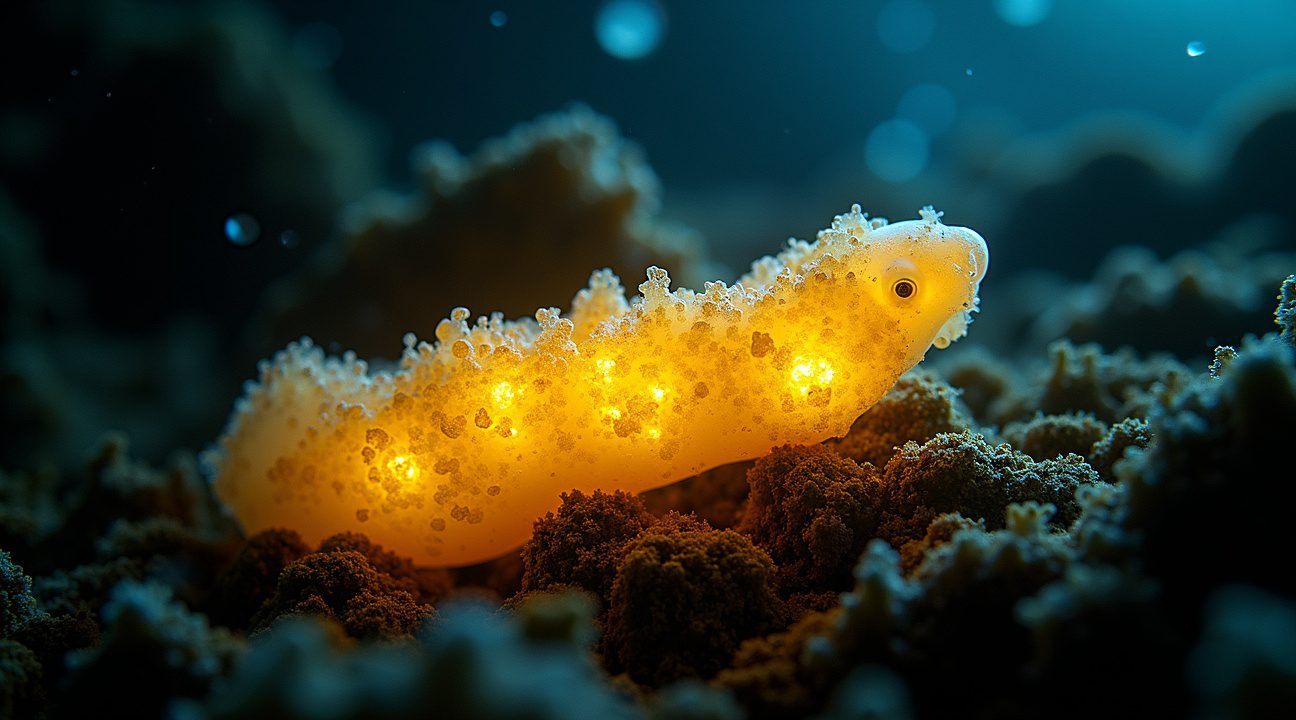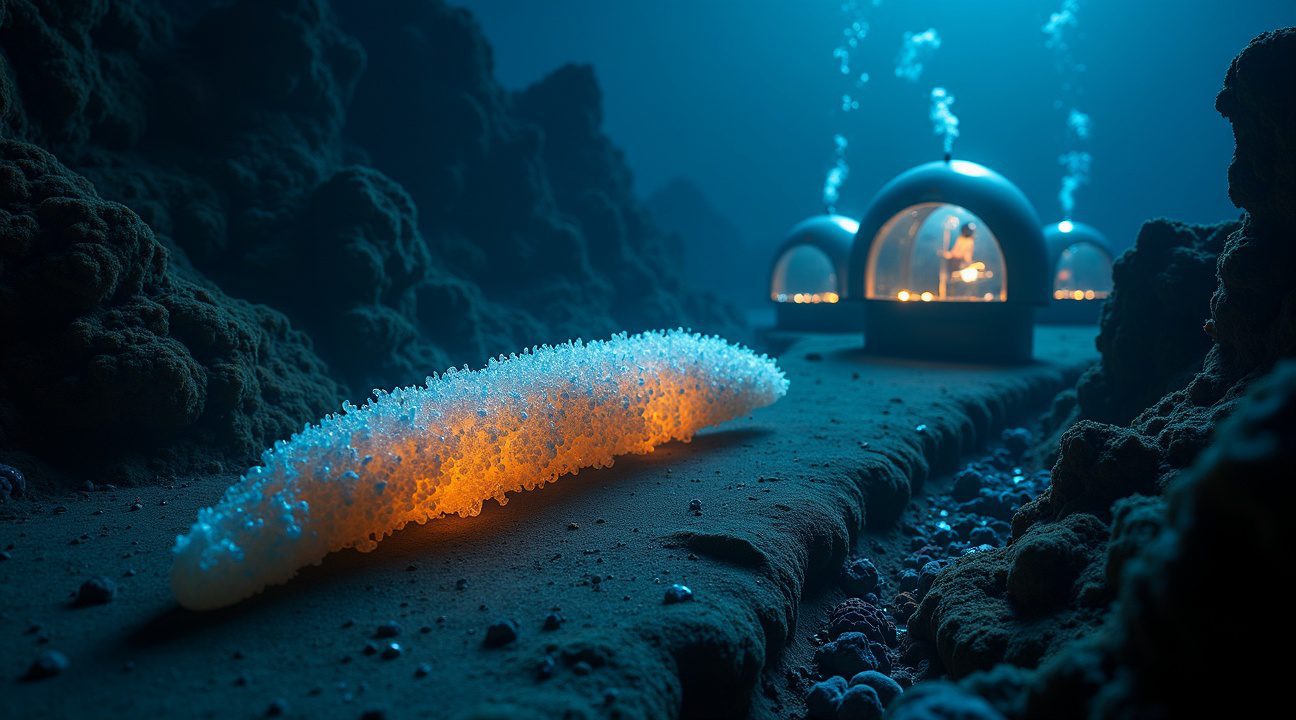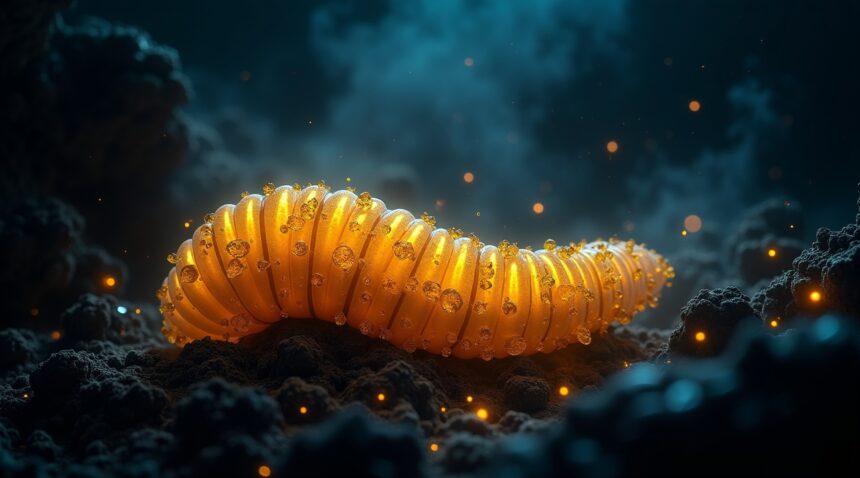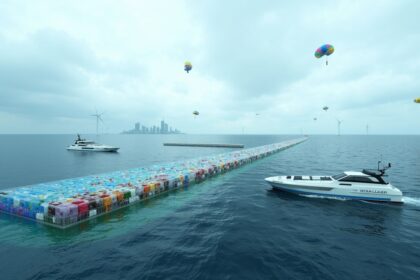Paralvinella hessleri, a vibrant yellow deep-sea worm inhabiting Pacific Ocean hydrothermal vents, has mastered survival in one of Earth’s most poisonous environments through an extraordinary adaptation.
Scientists have discovered that this remarkable creature survives by transforming highly toxic compounds—arsenic and sulfide—into a harmless substance called orpiment. This bright golden crystal formation not only contributes to the worm’s distinctive appearance but also demonstrates a novel survival mechanism scientists describe as “fighting poison with poison.” The crystals form within specialized skin cells, protecting the worm from a habitat that would otherwise be fatal.
Key Takeaways
- The worm converts deadly arsenic and sulfide toxins into golden orpiment crystals through an intracellular biomineralization process, resulting in its shimmering yellow hue.
- This “fighting poison with poison” adaptation allows the organism to thrive in hydrothermal vent environments where extreme toxicity renders them inhospitable to most life.
- The golden crystals develop continuously inside specialized skin cells, functioning as both a detox system and a defense barrier against toxic threats.
- This breakthrough could reshape environmental cleanup technologies by offering a biological model for transforming harmful pollutants into safe crystalline substances.
- The research expands our understanding of extremophile survival strategies and could inspire innovations in biotechnology related to medicine, advanced materials, and even space travel.
For more details on this groundbreaking discovery and its implications, you can read the original report as covered by Live Science.
Deep-Sea Worm Transforms Deadly Poison Into Glowing Golden Crystals
Paralvinella hessleri has mastered one of nature’s most extraordinary survival strategies. This bright yellow, glowing worm thrives near hydrothermal vents in the Pacific Ocean, where toxic chemicals would kill most life forms instantly.
Scientists have discovered that this remarkable creature has evolved an intracellular process that defies conventional biology. The worm actively detoxifies arsenic and sulfide by merging these deadly substances into golden mineral crystals called orpiment (As₂S₃). This biomineralization process represents a unique adaptation that allows the worm to turn environmental hazards into harmless crystalline structures.
The “Fighting Poison with Poison” Strategy
The detoxification method employed by Paralvinella hessleri follows a principle researchers describe as “fighting poison with poison.” Instead of expelling these toxic compounds from its body, the worm combines arsenic and sulfide—two substances that are lethal on their own—into an inert, crystalline mineral that poses no threat to its cellular functions.
This intracellular adaptation showcases how life can evolve extraordinary solutions under extreme conditions. While most organisms would perish in environments rich with both arsenic and sulfide, this deep-sea dweller has turned these toxic elements into its signature feature. The process demonstrates nature’s ability to transform environmental challenges into evolutionary advantages.
Golden Glow From Living Crystals
The orpiment crystals form visible clusters inside the worm’s skin cells, creating the distinctive golden glow that makes Paralvinella hessleri so remarkable. These crystalline formations aren’t just protective mechanisms—they’re the source of the worm’s luminescent appearance that sets it apart from other deep-sea creatures.
Each crystal cluster represents a successful neutralization of potentially lethal toxins. The golden crystals accumulate within specialized cells, creating a biological treasure trove that serves both protective and visual functions. This biomineralization process occurs continuously as the worm encounters fresh doses of arsenic and sulfide in its hydrothermal vent habitat.
The worm’s ability to create these golden crystals while maintaining normal biological functions represents a breakthrough in understanding extreme-environment adaptations. Unlike other deep-sea organisms that simply avoid toxic substances, Paralvinella hessleri actively incorporates them into its survival strategy.
Environmental conditions near hydrothermal vents create a perfect storm of chemical challenges. These underwater volcanic formations release concentrated doses of heavy metals, sulfur compounds, and other toxic materials that would overwhelm most biological systems. Yet this golden worm has evolved to use these very toxins as raw materials for its crystalline armor.
The discovery of this detoxification mechanism opens new possibilities for understanding how life adapts to extreme environments. Scientists studying Paralvinella hessleri are gaining insights into cellular processes that could inform biotechnology applications and environmental remediation strategies. The worm’s method of combining two poisons into a harmless compound challenges traditional approaches to dealing with toxic substances.
Research into this organism’s unique adaptation continues to reveal the sophisticated biochemical machinery required for successful biomineralization. The precision with which the worm controls crystal formation while maintaining cellular integrity demonstrates the remarkable evolutionary solutions that emerge under pressure. This golden-glowing creature proves that even in Earth’s most hostile environments, life finds ways not just to survive, but to transform challenges into advantages.

Surviving Earth’s Most Toxic Underwater Environment
Hydrothermal vents represent some of the most hostile environments on our planet, spewing superheated water that often exceeds 350°C while pumping toxic minerals into the surrounding ocean depths. I find these underwater volcanic systems particularly fascinating because they create conditions that would instantly kill most marine life. The water carries lethal concentrations of arsenic and sulfide, creating a chemical soup that defies survival for nearly all ocean creatures.
The Lethal Chemistry of Deep-Sea Vents
Arsenic concentrations around these vents reach staggering levels, with some species like Paralvinella hessleri accumulating over 1% of their body weight in this deadly element. The combination of boiling temperatures and high toxicity creates an environment where survival seems impossible. Most marine organisms cannot even approach these areas without facing immediate death from either the extreme heat or the poisonous chemical cocktail that surrounds the vents.
This deep-sea environment challenges every assumption about life’s limits. The toxic minerals that flow from these underwater volcanic systems would kill terrestrial animals within minutes, yet some remarkable creatures have found ways to not just survive but actually thrive in these conditions.
Standing Out in a Hostile World
Paralvinella hessleri breaks every rule of survival in these extreme conditions. While most hydrothermal vent animals display muted colors that help them blend into the dark depths, these extraordinary worms glow with vivid yellow hues that make them stand out dramatically against the vent landscape. Their bright coloration comes from their unique ability to process the very toxins that kill other creatures.
The worm’s extremophile nature allows it to convert deadly arsenic into golden crystals within its body, essentially turning poison into treasure. This survival adaptation represents one of nature’s most remarkable examples of biological alchemy. Rather than being overwhelmed by the toxic environment, these worms have evolved to use the lethal chemistry as a resource, transforming what should be their death sentence into their key to survival in the hydrothermal vent ecosystem.
The Renaissance Art Connection Hidden in Marine Biology
Renaissance painters cherished orpiment for its brilliant golden hue, creating masterpieces that continue to captivate viewers centuries later. This arsenic-based mineral delivered the most vibrant yellow pigment available to artists of the era, though its extreme toxicity required careful handling. Masters like Vermeer and other prominent painters risked their health to achieve those luminous golden tones that define many Renaissance works.
Scientists never expected to find this same toxic mineral thriving inside living cells. The deep-sea worm’s ability to crystallize orpiment within its skin represents an unprecedented biological phenomenon that bridges art history with marine science. This discovery reveals how nature has developed its own artistic palette, using the same dangerous compound that Renaissance artists prized for their paintings.
Revolutionary Biological Adaptation
The formation of visible orpiment clusters inside animal cells challenges everything researchers thought they knew about cellular toxicity limits. Most organisms cannot survive arsenic exposure, yet this remarkable worm has evolved to transform the poison into protective golden crystals. The adaptation suggests that extreme deep-sea environments have pushed evolution beyond conventional boundaries.
Marine biologists must now reconsider how invertebrates adapt to toxic conditions in the ocean’s depths. This worm’s unique survival mechanism opens new research avenues into biological detoxification processes. Scientists studying deep-sea adaptations are particularly excited about the implications for understanding life in extreme environments.
The convergence of Renaissance art materials and modern marine biology demonstrates how scientific innovation often emerges from unexpected connections. Artists who worked with orpiment centuries ago unknowingly shared a material connection with one of nature’s most extraordinary creatures. This link between historical pigments and contemporary biological discoveries highlights how different fields of study can illuminate each other in surprising ways.
The worm’s crystallization process represents a form of biological alchemy that rivals any artistic technique. While Renaissance painters mixed orpiment with oils and binders to create their golden masterpieces, this marine organism has perfected an internal process that achieves similar visual results. The scientific community continues investigating how these biological adaptations might inform future biotechnology applications and environmental remediation strategies.
Breakthrough Research Methods Reveal Cellular Secrets
Scientists from the Institute of Oceanology, Chinese Academy of Sciences employed cutting-edge analytical techniques to uncover the extraordinary survival mechanism of this luminescent deep-sea worm. Their groundbreaking findings, published in PLOS Biology, demonstrate how advanced research methods can reveal nature’s most fascinating adaptations.
Advanced Analytical Techniques
The research team utilized a comprehensive suite of investigative tools to decode the worm’s remarkable cellular processes. Microscopy allowed scientists to visualize the golden crystal formations within the creature’s skin cells at unprecedented resolution. Spectroscopy revealed the precise chemical composition of these protective structures, confirming their unique mineral properties.
DNA analysis and protein analysis provided crucial insights into the genetic machinery that enables this extraordinary transformation. These molecular techniques helped researchers identify the specific enzymes and cellular pathways responsible for converting deadly toxins into protective golden armor. Each analytical method contributed essential pieces to solve this biological puzzle.
The Cellular Process Unveiled
Through careful examination using these advanced methods, scientists discovered exactly how arsenic and sulfide react within the worm’s skin cells. The cellular process begins when these toxic compounds enter the organism through its surrounding environment. Rather than succumbing to poisoning, the worm’s specialized cells orchestrate a remarkable chemical transformation.
The research reveals that specific cellular components facilitate the binding of arsenic and sulfide molecules, creating stable crystal structures that appear golden under certain lighting conditions. This process occurs continuously within the creature’s skin, providing ongoing protection against the harsh chemical environment of deep-sea volcanic vents. The crystals act as both a detoxification system and a protective barrier, allowing the worm to thrive in conditions that would prove fatal to most other organisms.
Scientists noted that this cellular adaptation represents one of nature’s most efficient detoxification mechanisms. The precision of this biological process rivals synthetic chemical reactions, yet occurs naturally within living tissue. Understanding these mechanisms could inspire new approaches to environmental cleanup and medical treatments for heavy metal poisoning.
Similar discoveries about deep-sea adaptations continue to expand our knowledge of life in extreme environments. The detailed analysis published in PLOS Biology sets a new standard for studying extremophiles and their remarkable survival strategies.
Broader Implications for Deep-Sea Life and Environmental Science
The remarkable poison-to-crystal conversion mechanism exhibited by this luminescent deep-sea worm extends far beyond a single species discovery. Scientists believe this adaptation likely exists in related deep-sea worm species and snails throughout the western Pacific, indicating an evolutionary strategy that developed across multiple lineages. This widespread occurrence suggests that biomineralization research has only scratched the surface of nature’s detoxification capabilities.
Revolutionary Applications in Environmental Management
Environmental adaptation studies now have a powerful new model for developing bio-remediation technologies. The worm’s natural detox processes offer a blueprint for creating systems that could transform environmental pollutants into harmless or even valuable materials. Bio-remediation applications could revolutionize how industries handle toxic waste, potentially converting harmful substances into useful crystals rather than simply containing them.
Engineers and environmental scientists are particularly excited about the potential for developing new materials inspired by the worm’s mechanism. The golden crystals produced through this biological process could lead to breakthrough innovations in manufacturing and environmental cleanup technologies. Scientists working with deep-sea organisms have long sought practical applications from extremophile biology, and this discovery provides a concrete pathway forward.
Expanding Extremophile Research Horizons
This discovery sets an important precedent for exploring how other extremophiles handle toxic conditions in harsh environments. Evolutionary biology researchers now have a documented example of how organisms can transform deadly substances into beneficial structures, opening new avenues for investigating similar adaptations across different species and environments.
The implications extend to understanding how life persists in some of Earth’s most challenging conditions. From deep ocean trenches where massive sea creatures thrive to toxic industrial sites, this worm’s strategy could inform efforts to identify other organisms with similar capabilities. Environmental scientists anticipate that studying these mechanisms will reveal additional natural solutions for addressing pollution and contamination challenges that currently require expensive technological interventions.
Future research will likely focus on understanding the genetic and biochemical pathways that enable this transformation process. By decoding these mechanisms, scientists could potentially engineer similar systems for large-scale environmental applications, creating a new category of biological tools for managing human-made pollution.
The Future of Biomineralization and Toxin Management
This groundbreaking discovery transforms how I understand biological responses to environmental threats. The glowing worm’s remarkable ability to convert poison into golden crystals represents a paradigm shift in biomineralization research. Scientists can now envision revolutionary approaches to environmental cleanup that harness similar biological mechanisms.
The implications for industrial pollution control are staggering. Current toxic waste management systems rely heavily on expensive chemical treatments and energy-intensive processes. By studying this worm’s detoxification pathway, researchers could develop bio-inspired solutions that naturally neutralize harmful substances. Companies dealing with heavy metal contamination might soon implement biological systems that mirror the worm’s crystal formation process.
Expanding Research into Deep-Sea Adaptations
Deep-sea environments house countless organisms that have evolved extraordinary survival mechanisms. I anticipate that researchers will now intensify their search for similar adaptations in other species living near hydrothermal vents and toxic seepage areas. The deepest fish discoveries already hint at the incredible adaptations possible in extreme marine environments.
Scientists should focus their investigations on these key areas:
- Organisms living near deep-sea mining sites where heavy metals concentrate
- Species thriving around underwater volcanic activity with high sulfur content
- Creatures inhabiting areas with natural petroleum seepage
- Microorganisms in sediments with elevated toxin levels
The convergence of biology, chemistry, and materials science creates unprecedented opportunities for innovation. Materials scientists can study the worm’s crystal structure to develop new composite materials with enhanced properties. Environmental engineers might design bioreactors that replicate the worm’s detoxification process on an industrial scale.
Pharmaceutical companies are already expressing interest in understanding how the worm’s biological pathways could inspire new drug delivery systems. The precision with which this organism converts toxins into crystalline structures suggests highly efficient enzymatic processes that could revolutionize biotechnology applications.
Academic institutions are positioning themselves to lead interdisciplinary research programs that combine marine biology with environmental engineering. These collaborations will likely produce breakthrough technologies for addressing pollution challenges that have plagued industries for decades. The worm’s mechanism offers a sustainable alternative to traditional waste treatment methods that often create secondary environmental problems.
This research also opens doors for space exploration applications. Understanding how organisms neutralize toxins in extreme environments could prove invaluable for developing life support systems for Mars missions or other planetary exploration endeavors. The biological principles discovered in this deep-sea worm might help scientists design systems that protect astronauts from radiation and other space-based toxins.

Sources:
EdutalkToday.com, “The Bright Yellow Worm That Turns Ocean Poison Into Golden Crystals”
SciTechDaily, “The Bright Yellow Worm That Survives by Turning Poison into Gold”
Discover Magazine, “This Worm’s Golden Color Is Toxic, But Is Necessary to Survive in the Deep Sea”
ScienceDaily, “The bright yellow worm that turns ocean poison into golden crystals”


